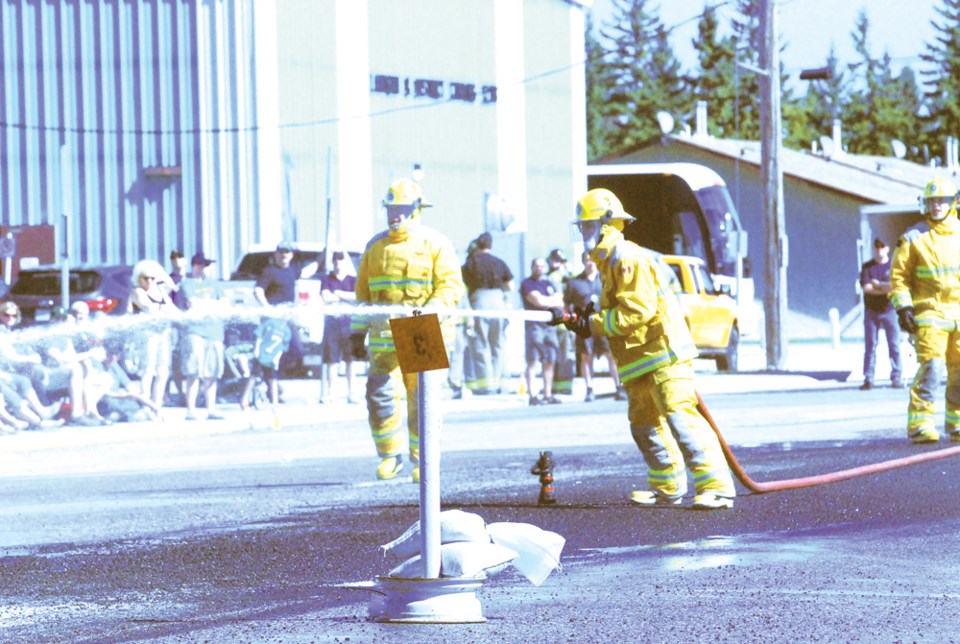Forty firefighters and 20 coaches took part in the Annual Firefighter Rodeo in Lanigan on Sept. 12.
Firefighters from multiple potash mines in the area as well as both the City of Humboldt and the Town of Lanigan fire departments competed in seven events designed to test their skill and training.
The first aid event, which was set up by St. John’s Ambulance, created a scene of an accident with an injuried man and a bystander. The team had to come on the scene, assess the damage and respond to the senerio.
Dwayne Krawchuk with St. John’s Ambulance in Saskatoon was “injured“ in a farming accident and was unresponsive on the scene. There was no blood but there were other injuries that the team had to watch out for.
“They’ll see a bruise on the forehead and a bruise on the chest, which will indicate both a head and chest injury. For them, that will require immediate spinal immobilization,” said Krawchuk.
His partner, Shane Collinson, does not appeared injuried but he has an epilepetic seizure during the scenerio.
Team members not only respond to the injuried persons but also have to take care with the surrounding environment as well.
“They are responding to the scene and they really don’t know what they are getting themselves into until they actually get to the scene,” Krawchuk said.
From turning off the tractor and truck and putting blocks under the wheels to moving the open tool box away from the victim, making the scene safe for those responding to the call was just as important as accessing the injured person, says Krawchuk.
The extinguisher drill gives the teams three fires to extinguish with a limited number of fire extinguishers.
“The captain is showed the props and has to assign his fire fighting tools appropriately,” said event co-ordinator Sean Linton.
The controlled burn is representative to something the crews would fight at their mine sites or when they respond to a call.
“This would simulate any sort of small fire that they would be able to fight with a fire extinguisher on site,” he said.
The search and rescue event took teams from street clothes into a “burning building” to rescue the “people” inside.
Gary MacDonald, who has been an emergency response technician for 40 years judged how the team communicated with each other and how they worked as a team.
Two teammates went into the building with tape over their helmets to simulate a smoke environment and had ten minutes to navigate through the maze of lumber and furniture.
The practical skills event was a demonstration of a specific firefighting skill. Knot tying was featured in this event, says event co-ordinator Doug Poole.
“They have to know their knots, how to tie their equipment so it can be raised and lowered into burning buildings or a place of rescue,” he said.
Previous events featured other specific skills such as confined space entry and rescue vehicle extrication.
“We try to come up with a skill that they have to demonstrate in everyday,” Poole said.
When judging the event, safety was a big focus. Making sure knots are secure and making sure no one was in the drop zone was a number one priority, said event judge Len Bergen.
Even when things look secure, there can always be that chance that it is not.
One team actually dropped a fire extinguisher, which was their excitement for the day, said Bergen.
“To us, the knot looked tight but depending on how the knot was on top of the fire extinguisher and the handle, it actually slipped a little bit,” he said.
In a real life situation, a fully-charged extinguisher could have gone off when dropped.
The burst hose event saw teams connecting hoses and knocking down specified targets as quickly as they can. As soon as designated targets were knocked down, the hoses had to be switched and other targets had to be knocked down.
The challenge relay saw all five teammates do five specific tasks. Teams were timed as they drove a railway tie four feet with a sledgehammer, dragged a victim 100 ft., pulling hose 100 ft. and then knocking down two targets, extinguishing a fire and turning off a sprinkler system.
The last event was the only one that saw teams go up against each other. In water soccer, teams had to spray a metal canister hanging on a wire to the opposing team’s side. The first team to score on the opposing team won.
For rodeo planner Terry Wruck, the whole competition had nothing to do with winning events.
“It’s not about the trophies you take home. Those are just bonuses,” he said.
Building camaraderie between firefighters was a big focus for the event. When all the events are over, all the firefighters got together for a group shot and exchanged souvenirs.
“That’s the brotherhood of firefighting,” Wruck said.




